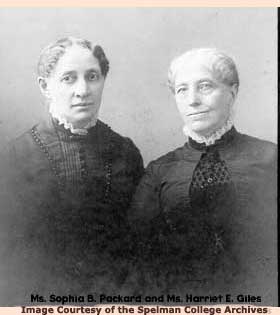Father Quarles and Aunt Ruth: Leaders for Spelman and All of Georgia
by Deborah Mitchell
(Spelman class of 1980)
From an Oral History Provided by Murial Ruth Ketchum Yarborough
(Spelman class of 1949)
After the Civil War, African Americans all over the South were seeking educational opportunity, which was often hard to come by. Even after some progress had been made, especially in schools for young children, education for African American women was lacking in the Atlanta area.
Reverend Frank Quarles and a group of other black Atlanta citizens prayed together continually about that situation. At the same time, the American Missionary Association and other Northern philanthropic groups were looking for places to aid blacks in their educational pursuits.
These two groups came together in Atlanta when Sophia Packard and Harriet Giles, who had come south from New England to support black education, joined forces with Reverend Quarles and the local community he led. When Miss Packard and Miss Giles first had the idea for starting a school for African American women in the south, they tentatively planned on Louisiana as their location. Packard and Giles had visited Atlanta on their way to Louisiana and they found the climate more appealing in Georgia. They were drawn back to Atlanta because of the level of local support from people like Reverend Quarles-support they knew would be essential for their efforts.
Spelman's start as an educational institution began in the basement of Father Quarles' church.

Excited as the community was about opening this school, Reverend Quarles was quickly at work trying to raise additional funds to create a larger and more permanent facility. During just such a fundraising trip in the north, unfortunately, Father Quarles became ill and died before he could see the full embodiment of his vision. But the dreams of Quarles and the community lived on in the work of others.
Perhaps one of the best measures of the power of Quarles' dream can be found in stories of the women from his family who came after him, attended Spelman, and made contributions of their own to education. One line of the Quarles family tree that represents this pattern was the branch of Murial Ruth Ketchum Yarborough. Related to Quarles on one side (he was her great grandfather), "Aunt Ruth" had other educational pioneers on the other side of her family tree.
As a prime example, Aunt Ruth herself loves to cite the work of her great grandmother Katie Screen. If Father Quarles was an institution-builder, Mother Screen was a leading educational practitioner. When slavery was over, the master who had owned Screen's family gave each of his slaves-including Henry Screen (Katie's father)-10 acres of land. Farming these lands, the various families from that former master were very spread out from each other. But they wanted to have a school to serve their children. Even today, Aunt Ruth lovingly repeats the story which her grandmother Katie Screen loved to tell-the story of children of former slaves walking from all over the area to a school. The walk was so long that Katie remembers a certain section of the road which the children called "Five Miles Still," to mark how much further they would need to walk to get to their school. When a local man, Richard Johnson, decided to open a new school so the area children would not have to walk so far, Katie Screen began her career as a teacher.
The two branches of Aunt Ruth's family tree-both dedicated to education-came together when Frankie Quarles (daughter of Reverend Quarles) married the son of Katie Screen and Richard Johnson. The daughter of Katie and Richard was Gertrude Johnson, who (like Frankie Quarles before her) attended Spelman and became a teacher. Mother Gertrude passed on the stories of these two families to her daughter Ruth, our source of information for the account you are reading now.
For the descendents of Frank Quarles and Katie Screen, servant leadership through education has remained a constant goal. Describing this commitment, "Aunt Ruth" still says today, "Mother told us, you pass it on." Referring especially to Frank Quarles, Mother Gertrude always cautioned Aunt Ruth and other children in the family, "You can't live on what he did." At the same time, though, she emphasized that her children should remember that "all he had [at first] was that dink-damp basement and his dreams," yet he made those dreams come true.
Building on that heritage, Mother Gertrude always stressed to her children, "You do as much as you can, for as many as you can, as well as you can, for as long as you can." For Aunt Ruth, this servant leadership principle has continued to be framed as an educational mission: "Take a child where he is, and take him where you want him to be."
Click Here for additional notes on the development of this material
Creating a New Context for Studying African Americans' Post-Civil War Education
by Sarah Robbins
A Timeline of Spelman College's Early History
by Ed Hullender
Early Graduates: Writers and Community Leaders
Transcriptions from the Spelman Messenger
Reflections on Writing (from) an Oral History
by Deborah Mitchell
Doing Archival Research
by Ed Hullender
Bibliography
by the "Educating for Citizenship" Team
Content Design/Management: Traci Blanchard and Marty Lamers
Home | Curricular
Program | Thematic Content
Classroom Resources
| Community Projects |
Who We Are
© 2000-2001KCAC
No materials on this website should be copied or distributed
(except for classroom use) without written permissions from KCAC.
Questions? Comments? Contact KSU webmaster
Jim Cope.



